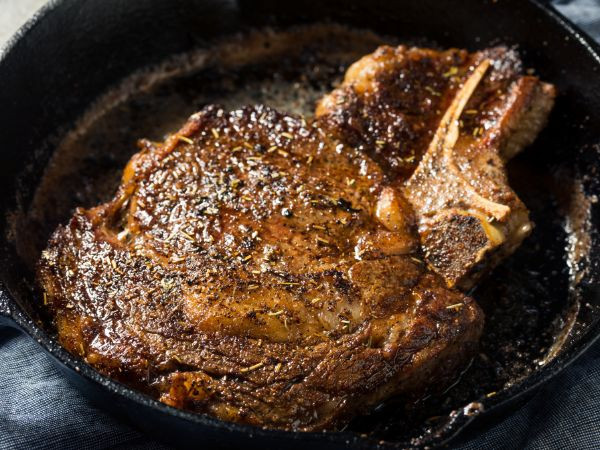Grass-Fed vs. Grain-Fed Beef and Lamb: What’s the Difference?
posted on
April 25, 2025

When choosing beef or lamb for your next meal, you might have noticed labels like “grass-fed” or “grain-fed.” These terms define how cows and lambs are raised and fed, impacting everything from nutritional value to environmental sustainability.
Lamb and beef production methods also significantly impact environmental sustainability, with grain-fed animals often resulting in quicker market cycles and lower resource usage compared to traditional grass-fed practices. But what does this mean for your health, taste preferences, and the planet?
Let’s break it down.
When it comes to choosing the right type of meat, consumers are often faced with a variety of options. Two of the most popular types of meat are grass-fed and grain-fed. Grass-fed beef and lamb come from animals raised on a diet of grass, while grain-fed beef and lamb come from animals raised on a diet of grains. Grass-fed meat is often considered a more natural diet for cows and lambs, as it allows them to eat what they would naturally eat in the wild. On the other hand, grain-fed animals are often produced using growth hormones and antibiotics, which can have negative effects on both the environment and human health. Understanding these differences can help consumers make informed decisions that align with their health goals and ethical values.
Nutritional Differences
One of the prominent distinctions between grass-fed and grain-fed meat is in their nutritional profiles. Grass-fed beef cattle and lambs generally contain higher amounts of specific nutrients, such as Omega-3 fatty acids and vitamins. Here’s how they stack up:
Grass-Fed Meat
- Omega-3 Fatty Acids Grass-fed animals graze primarily on grass, resulting in significantly richer meat in omega-3 fatty acids. These healthy fats are crucial for brain function, heart health, and reducing inflammation. Studies indicate that omega-3 levels in grass-fed meats are up to five times higher compared to grain-fed options.
- Vitamins and Antioxidants. Pasture-raised meats are also a great source of essential nutrients like vitamin E, beta-carotene (a precursor to vitamin A), and higher levels of conjugated linoleic acid (CLA), known for supporting fat metabolism and promoting overall health.
- Leaner Meat Grass-fed beef and lamb tend to be leaner than their grain-fed counterparts, which translates to fewer calories per serving. While the meat may have less marbling, the natural, robust flavour often appeals to those seeking more traditional or earthy taste profiles. Additionally, the lower fat content in grass-fed meat affects the cooking process, as it can become tough if not prepared with care. This lower fat content also emphasizes the health benefits, noting that a grass diet leads to healthier cattle and a more nutrient-rich meat product.
Grain-Fed Meat
- Higher Fat Content Animals that are grain-fed are typically raised on a diet of corn, soy, and other grains. This produces a more heavily marbled meat, resulting in a richer, oilier texture. Grain-fed meat is higher in saturated fats and calories due to the increased marbling of the meat.
- Lower Nutrient Density Grain-fed meats generally have fewer omega-3 fatty acids and lower levels of specific vitamins such as E and A.
- Milder Flavour The flavour of grain-fed meat is often described as milder. This taste profile is mainly due to the animal’s grain-heavy diet.
When it comes to choosing based on nutrition, grass-fed edges out grain-fed meat in terms of omega-3 content, vitamin levels, and leaner cuts.
Finished Beef and Lamb Options
Finished beef and lamb refers to animals that have been raised on a farm and finished on a specific diet. Several types of finished beef and lamb options are available, including those from grass-fed cows and lambs, as well as grain-fed options. Grass-fed and finished is considered a higher-quality option, allowing cows and lambs to eat a natural diet and roam in open pastures. Grain-fed and finished, on the other hand, is often produced using large feedlots and may contain higher levels of fat and calories.
When choosing a finished option, consumers should consider the diet and living conditions of the animals, as well as the potential environmental impact of the production process.
Which One Should You Choose?
Ultimately, the choice between grass-fed and grain-fed meat comes down to your consumer priorities:
- Nutritional Needs: If you’re emphasizing leaner protein sources rich in omega-3s and vitamins, grass-fed is a natural fit.
- Taste Preference: Grass-fed meat has a more intense, earthy flavour, while grain-fed meat is oily and mild. Most people have misconceptions about the toughness and flavour of grass-fed beef, which often stem from improper cooking methods.
By making informed choices, you can enjoy your meals while aligning your purchases with your values. If you're considering the nutritional benefits of meat, investing in grass-fed options is a fantastic choice. Grass-fed meat is often richer in omega-3 fatty acids, vitamins, and antioxidants than grain-fed alternatives, making it a healthier option for your diet.
For those who appreciate the taste and quality of grass-fed meat, connecting with local farms can be a rewarding experience. Supporting pasture-raised animals promotes sustainable farming practices and ensures that you consume meat raised in a more humane and environmentally friendly manner.
Choosing grass-fed meat nourishes your body while also supporting ethical farming practices and contributing to a healthier planet.
Shop our grass-fed and finished beef and lamb options today.







